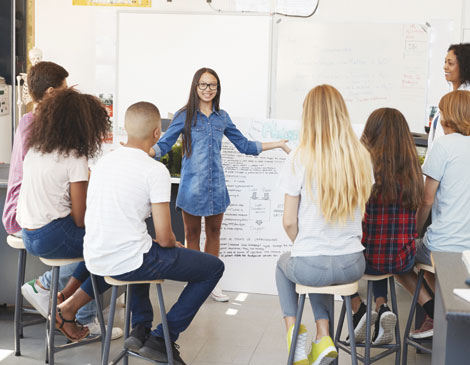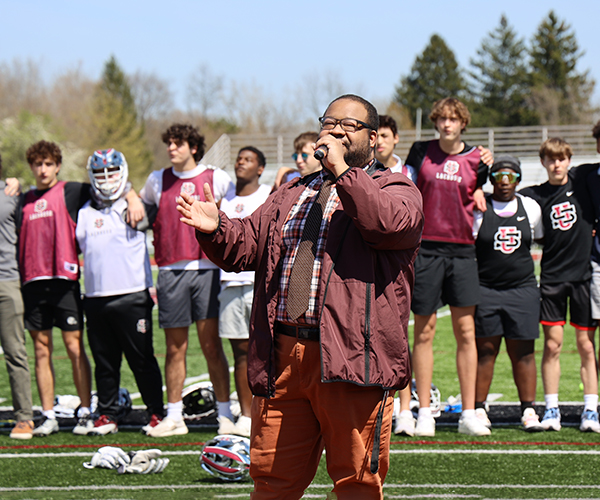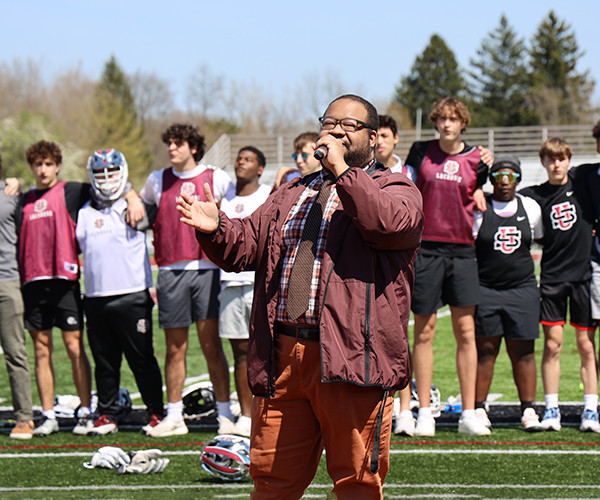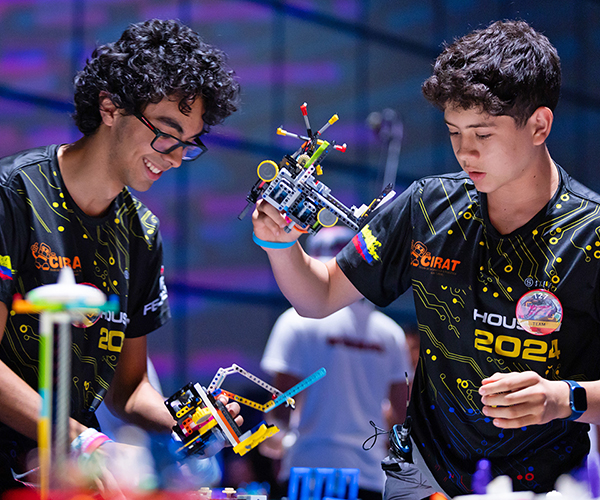At Lake Ridge Academy, the school day begins in the comfort zone.
For five minutes each morning, students huddle with an advisory group of about 10 students for a few moments to exhale and open up dialogue before the bell rings.
“As soon as I get to school, there’s a place to go with my friends,” says Connor Spencer, a 14-year-old freshman. “I can speak out and not worry about being embarrassed.”
During middle school, he recalls, the adviser often asked about the day ahead and any problems or obstacles. “You’d feel like, I can do that,” Spencer says.
The support opens up students to grow and take risks, says Connor’s mother Debbie Spencer. “The advisory groups created a place where students felt they could be free to be themselves, to try new things, to succeed and fail, and to be accepted no matter what happens,” she says.
Connor ran into some roadblocks in eighth grade, when he and classmates were working on their individual “leaps” — a personal learning project that could range from reading the 50 great novels to training for a triathlon. But the advisory group provided the support he needed.
Connor wanted to build an electric skateboard, but needed affordable computer-aided design software, mechanical parts and, of course, to design and build the project. The ambitious idea raised hurdles all along the way.
“At one point, I had a switch that was made for AC power and I couldn’t figure out why it wasn’t working,” he says. So he took the problem to a science teacher, who helped him realize the batteries were DC power.
Every morning in advisory group, his peers and a teacher-adviser discussed the projects’ successes and failures. The exercise was about developing problem-solving and collaboration skills while fostering empathy and understanding for when things go wrong for another classmate.
“We work through activities to help them develop their voice, and we do exercises to help them sort out who they are and what experiences have brought them to this point,” says Tim Unger, Lake Ridge Academy middle school director. “The goal is to help empower kids in their learning environment.”
Having a trusted adviser and peer group can put a student on track toward success.
Mentorship and advisory programs in school offer a host of benefits, including providing kids a safe place and a network for discussing tough issues.
In addition, at-risk kids with mentors are 55 percent more likely to go to college and 78 percent more likely to volunteer regularly, according to research by the National Mentoring Partnership. Youth who meet with mentors regularly are 81 percent more likely to participate in sports or extracurriculars and show a reduction in depressive symptoms.
At Lake Ridge, the grade-specific advisory groups and mixed-age “family groups” help build a more connected school, says social studies teacher and adviser Mat Barker.
“They get to know each other much more than on a you-sit-next-to-me level,” he says. “They know each other’s likes and dislikes. They understand if someone is having a bad day. They learn how to reach each other and really help each other out. It’s beneficial to our overall community because the groups make our kids empathetic.”
During the tween and teen years, kids often need that extra support. “Being a kid these days is tough,” says Sharon Baker, middle school director at Hathaway Brown School. “The more people you can have in your corner, the better.”
* * * * *
Gaining Independence
Advisory groups and mentors at school give students built-in confidantes.
At Hathaway Brown, even if students want to be invisible, they are not allowed to be, Baker says. “They know someone is paying attention to them all the time,” she says.
Hathaway Brown pairs a teacher with a group of about 10 girls who reflect a microcosm of the school population. This mentor-based model means students have someone to turn to with a question or problem.
“In particular, younger students might be struggling with something, but they don’t know who to go to for help,” Baker says.
So teachers are expected to pay a little extra attention to their advisor group.
“Advisers know where their students are sitting at lunch, they know if they got picked to play in the kickball game at recess or if they were struggling in gym and got made fun of,” she says. “The teachers know students so well, and the girls feel cared for.”
Sometimes, students simply need the reassurance that what they’re feeling is normal. That’s especially true during middle school as students enter puberty, interests shift and friend groups change.
“It is such a tough, rocky time,” Baker acknowledges. “It makes a difference to have an adviser say, ‘Honey, I know this feels terrible. I feel for you, and I want you to know this is really typical. You will get through it.’ That can de-escalate a feeling immediately when someone says it’s normal to feel this way.”
Those with mentors tend to trust their parents more and communicate better with them. As a mother, Debbie Spencer saw her son developing more independence.
“The advisory was a shared learning [experience],” she says. “They knew they could discuss things openly and they all learned together.”
While she doesn’t know exactly what was talked about — that’s between the adviser and the group — she understood that if there was a real concern a teacher would have let her know.
“There was a personal connection,” she says. “Connor could even text his teachers if he had a question. It’s good for the kids to know they have support all the time.”
* * * * *
Dealing with Stress
Advisory and mentorship programs come in different forms.
At Lake Ridge Academy and Hathaway Brown, groups of 10 to 12 students are paired with a teacher, who is supported with advisory training such as problem-solving and conflict resolution.
Advisory groups address certain topics during additional weekly breakout sessions.
At Lake Ridge, for example, the sixth-graders focus on the transition into middle school, seventh-graders take on a service project, and eighth-graders participate in a leap project.
At Hathaway Brown, advisory groups meet for 15 minutes each day with a weekly 50-minute class period dedicated to addressing common topics such as friendship tips, building interpersonal skills, leadership or bonding activities.
“Advisory is the heart of our programming,” Baker says.
The structure helps students navigate the social, emotional and academic pressures they’ll face during these years.
In fifth and sixth grades, for example, many students are dealing with friendship issues as their circles expand.
“We talk about what to do when you get dropped by your friendship group, and how to get into a new group,” she says. “They often bump into things they aren’t quite good at — like the first time they do poorly on a test and how to rebound and get through that.”
In seventh and eighth grade, Baker says, there’s more anxiety.
“Kids are coming into school and they’re anxious, not feeling confident in tackling problems,” she says. “So, we do a lot of work with building confidence.”
Advisory groups help calm the early-morning rush of stress.
“We can get them into these small groups and tell them they are in a safe place, surrounded by people who are caring for them and here to listen if they have a problem — and if they have good news to share, too,” says Rob Robertson, a science teacher at Lake Ridge.
Getting students out of the school environment to connect with advisers and their peer groups can build even stronger, trusting relationships, Unger adds. Family groups at Lake Ridge do annual Community Building Days that include an excursion like canoeing.
“It creates a culture that says, ‘It’s OK to talk to your teachers and get help in these nonacademic realms,’ ” he says.
* * * * *
Nurturing Future Careers
Mentoring can show students possibilities for the future and give them the confidence to pursue interests.
As a nonprofit focused on increasing postsecondary educational achievement, College Now Greater Cleveland supports the Cleveland Metropolitan School District’s True2U mentoring program, where professionals in the community volunteer once a month and deliver a curriculum to help students explore themselves and careers.
“We’re exposing students to what they can be when they grow up with real information,” says Michele Scott Taylor, College Now’s chief program officer. “That’s helpful because we find that kids from everywhere want to be what they see.”
The program brings professionals into the classroom to talk about potential careers and provides visits to companies and career fairs so students can get a firsthand glimpse.
“All students — not just those in a particular district — don’t have enough exposure to professions and careers, and especially what the educational requirements are to enter those professions or careers,” Taylor says. “That’s why we start early.”
The True2U program is offered to every eighth-grader in the Cleveland Metropolitan School District.
“It’s important to meet diverse professionals who do different things, so they realize they have more options and they can expand their dreams,” she says.
College Now helps high school students transition into college by pairing them with mentors who communicate regularly via e-mail for the duration of their college career.
“The mentors help students realize they don’t have to know everything right off the bat,” says Bob Durham, College Now’s director of scholarship services and financial aid. “Mentors share their personal experiences, and every two weeks there is a curriculum-based talking point.”
For example, a student might be challenged to set up a meeting with his or her academic adviser or to write an individual elevator speech.
By putting one more person in a student’s corner, College Now has dramatically increased graduation rates among its students. Before the program, first-year College Now students graduated from college about 60 percent of the time, which is well above the national average 41 percent. Now in its sixth year, the Mentorship Program has increased that number to 79 percent who have graduated or are in a fifth year.
However, mentorship doesn’t have to be formal and you don’t need a special degree to do it, Taylor stresses.
“You just have to be caring and competent and to want to see another person succeed in life,” she says. “The things you would do to help a family member or a child is what you can do to help a kid when it comes to their education and careers.”




